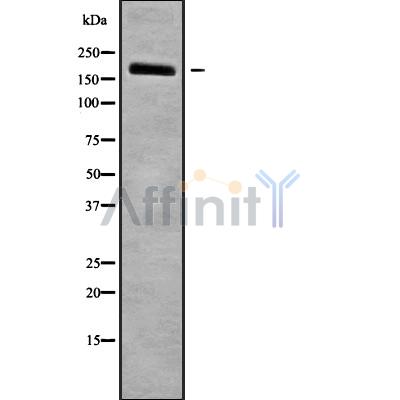NUP155 Antibody - #DF9708
| Product: | NUP155 Antibody |
| Catalog: | DF9708 |
| Description: | Rabbit polyclonal antibody to NUP155 |
| Application: | WB |
| Reactivity: | Human, Mouse, Rat, Monkey |
| Prediction: | Pig, Zebrafish, Bovine, Horse, Sheep, Rabbit, Dog, Chicken, Xenopus |
| Mol.Wt.: | 130,155 kDa; 155kD(Calculated). |
| Uniprot: | O75694 |
| RRID: | AB_2842903 |
Product Info
*The optimal dilutions should be determined by the end user.
*Tips:
WB: For western blot detection of denatured protein samples. IHC: For immunohistochemical detection of paraffin sections (IHC-p) or frozen sections (IHC-f) of tissue samples. IF/ICC: For immunofluorescence detection of cell samples. ELISA(peptide): For ELISA detection of antigenic peptide.
Cite Format: Affinity Biosciences Cat# DF9708, RRID:AB_2842903.
Fold/Unfold
155 kDa nucleoporin; ATFB15; D930027M19Rik; KIAA0791; mKIAA0791; N155; NU155_HUMAN; Nuclear pore complex protein Nup155; nucleoporin 155kD; Nucleoporin Nup155; Nup155;
Immunogens
A synthesized peptide derived from human NUP155, corresponding to a region within N-terminal amino acids.
Expressed in all tissues tested, including heart, brain, placenta, lung, liver, skeletal muscle, kidney and pancreas.
- O75694 NU155_HUMAN:
- Protein BLAST With
- NCBI/
- ExPASy/
- Uniprot
MPSSLLGAAMPASTSAAALQEALENAGRLIDRQLQEDRMYPDLSELLMVSAPNNPTVSGMSDMDYPLQGPGLLSVPNLPEISSIRRVPLPPELVEQFGHMQCNCMMGVFPPISRAWLTIDSDIFMWNYEDGGDLAYFDGLSETILAVGLVKPKAGIFQPHVRHLLVLATPVDIVILGLSYANLQTGSGVLNDSLSGGMQLLPDPLYSLPTDNTYLLTITSTDNGRIFLAGKDGCLYEVAYQAEAGWFSQRCRKINHSKSSLSFLVPSLLQFTFSEDDPILQIAIDNSRNILYTRSEKGVIQVYDLGQDGQGMSRVASVSQNAIVSAAGNIARTIDRSVFKPIVQIAVIENSESLDCQLLAVTHAGVRLYFSTCPFRQPLARPNTLTLVHVRLPPGFSASSTVEKPSKVHRALYSKGILLMAASENEDNDILWCVNHDTFPFQKPMMETQMTAGVDGHSWALSAIDELKVDKIITPLNKDHIPITDSPVVVQQHMLPPKKFVLLSAQGSLMFHKLRPVDQLRHLLVSNVGGDGEEIERFFKLHQEDQACATCLILACSTAACDREVSAWATRAFFRYGGEAQMRFPTTLPPPSNVGPILGSPVYSSSPVPSGSPYPNPSFLGTPSHGIQPPAMSTPVCALGNPATQATNMSCVTGPEIVYSGKHNGICIYFSRIMGNIWDASLVVERIFKSGNREITAIESSVPCQLLESVLQELKGLQEFLDRNSQFAGGPLGNPNTTAKVQQRLIGFMRPENGNPQQMQQELQRKFHEAQLSEKISLQAIQQLVRKSYQALALWKLLCEHQFTIIVAELQKELQEQLKITTFKDLVIRDKELTGALIASLINCYIRDNAAVDGISLHLQDICPLLYSTDDAICSKANELLQRSRQVQNKTEKERMLRESLKEYQKISNQVDLSNVCAQYRQVRFYEGVVELSLTAAEKKDPQGLGLHFYKHGEPEEDIVGLQAFQERLNSYKCITDTLQELVNQSKAAPQSPSVPKKPGPPVLSSDPNMLSNEEAGHHFEQMLKLSQRSKDELFSIALYNWLIQVDLADKLLQVASPFLEPHLVRMAKVDQNRVRYMDLLWRYYEKNRSFSNAARVLSRLADMHSTEISLQQRLEYIARAILSAKSSTAISSIAADGEFLHELEEKMEVARIQLQIQETLQRQYSHHSSVQDAVSQLDSELMDITKLYGEFADPFKLAECKLAIIHCAGYSDPILVQTLWQDIIEKELSDSVTLSSSDRMHALSLKIVLLGKIYAGTPRFFPLDFIVQFLEQQVCTLNWDVGFVIQTMNEIGVPLPRLLEVYDQLFKSRDPFWNRMKKPLHLLDCIHVLLIRYVENPSQVLNCERRRFTNLCLDAVCGYLVELQSMSSSVAVQAITGNFKSLQAKLERLH
Predictions
Score>80(red) has high confidence and is suggested to be used for WB detection. *The prediction model is mainly based on the alignment of immunogen sequences, the results are for reference only, not as the basis of quality assurance.
High(score>80) Medium(80>score>50) Low(score<50) No confidence
Research Backgrounds
Essential component of nuclear pore complex. Could be essessential for embryogenesis. Nucleoporins may be involved both in binding and translocating proteins during nucleocytoplasmic transport.
Phosphorylated. Phosphorylation and dephosphorylation may be important for the function of NUP155 and may play a role in the reversible disassembly of the nuclear pore complex during mitosis (By similarity).
Disulfide-linked to NUP62. The inner channel of the NPC has a different redox environment from the cytoplasm and allows the formation of interchain disulfide bonds between some nucleoporins, the significant increase of these linkages upon oxidative stress reduces the permeability of the NPC (By similarity).
Nucleus>Nuclear pore complex. Nucleus membrane>Peripheral membrane protein>Cytoplasmic side. Nucleus membrane>Peripheral membrane protein>Nucleoplasmic side.
Note: In mitosis, assumes a diffuse cytoplasmic distribution probably as a monomer, before reversing back into a punctate nuclear surface localization at the end of mitosis.
Expressed in all tissues tested, including heart, brain, placenta, lung, liver, skeletal muscle, kidney and pancreas.
Belongs to the non-repetitive/WGA-negative nucleoporin family.
Research Fields
· Genetic Information Processing > Translation > RNA transport.
Restrictive clause
Affinity Biosciences tests all products strictly. Citations are provided as a resource for additional applications that have not been validated by Affinity Biosciences. Please choose the appropriate format for each application and consult Materials and Methods sections for additional details about the use of any product in these publications.
For Research Use Only.
Not for use in diagnostic or therapeutic procedures. Not for resale. Not for distribution without written consent. Affinity Biosciences will not be held responsible for patent infringement or other violations that may occur with the use of our products. Affinity Biosciences, Affinity Biosciences Logo and all other trademarks are the property of Affinity Biosciences LTD.
